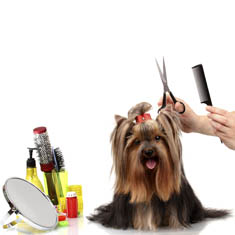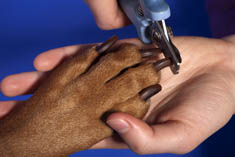Grooming: Choosing the Right Tool for the Job
So you want your dog to look like he or she is fit to compete at Westminster, but there are about 53 million different types of grooming tools at your local pet store. How do you choose?

Clippers
Although tempting during shedding season, a dog should never be shaved bald. Doing so can cause sunburn and can interfere with the dog's natural cooling ability. The fur actually traps air which helps the dog cool off.
While shaving the dog entirely is out, clipping the fur very short can be a workable alternative. The short hair will be easier to care for and less likely to pick up burrs when you go for hikes. Look for clippers that feature detachable blades you can use to choose the length of fur you want to leave on the dog. Usually, the lower the number on the blade, the shorter the coat will be when you finish.
If you have a dog whose fur tends toward the unkempt, a so-called "puppy clip" might be the solution. By keeping the coat relatively short, you can avoid matting and knots. If your dog spends a lot of time outdoors, he or she might pick up a lot of mud, bugs, and other organic matter. The shorter cut can minimize this.
De-Shedding
Nearly all dogs shed, but those with double coats are especially prone to dropping more fur than they seemingly retain during the spring and fall. There are a number of ways to deal with the avalanche of fur. One of the easiest to use is the grooming mitt. The mitt looks like an oven mitt and usually fits on either hand. The surface may be rubberized or made of cloth, usually with nubs that stick up to trap the hair. By simply petting the dog, you are removing loose fur.
A shedding blade is a loop of metal with a serrated edge, with the ends tucked into a plastic handle. One of the ends can be taken out of the handle to use the tool as a straight blade if desired. Running the serrated edge of the tool over the dog's coat knocks loose the fur that is ready to come out.
Just about any brush will remove loose fur, but the undercoat rake is especially effective. Double rows of teeth remove the undercoat while leaving the top coat alone.

The best product for removing shed undercoat on the market today is probably the one made by Furminator. Similar to an undercoat rake, this tool removes copious amounts of loose fur and captures it in the teeth of the tool, allowing you to dispose of it easily before it blows away. Many of the other tools remove the fur but don't keep it together, so it gets all over your house anyways. This tool keeps it in a clump so you can pull it out and put it in a trash bag after every couple of strokes.
Do NOT use the Furminator on dogs with very short coats, as it will cause discomfort. Also, if your dog has a very curly coat like a Poodle, it may tangle in the tool. The Furminator de-shedding tool comes in various sizes to meet your needs regardless of how large or small your dog is.
Every-Day Care
On a day-to-day basis, you may just want to brush your dog to clean loose dirt and broken hair from his or her coat. The slicker brush separates and lifts the hair away from the dog's body, giving a fuller appearance to the coat. It removes tangles and distributes the oils from the dog's skin throughout the coat. These are great for dogs with wiry or tough coats.
A pin brush looks very similar to the one you may use on your own hair. It may have metal or rubberized pins. Some are two-sided, with metal pins on one side and rubberized pins on the other. Alternatively, there may be pins on one side and a bristle brush on the other. The bristle side is used for smoothing the coat and making it shiny.
Brushes can be used alone or with any one of a number of sprays meant to de-tangle, add shine, condition the coat, or clarify colors.
Nail Care
There are three primary ways to shorten and care for your dog's nails: files, grinders, and trimmers. The nail file is used like an emery board to shape and shorten your dog's nails - pretty simple.
The grinder does the same thing as the file, but it uses a motorized wheel rather than your elbow grease to do the deed. The noise the grinder makes may be irksome to your dog, so you'll need to take the time to introduce it to your dog slowly.
Nail clippers usually include a guide with a hole in it, and a guillotine-type blade that slides across the guide hole when you squeeze the handles together, snipping off the tip of the nail.
Most dogs don't like to have their feet handled, and are notoriously skittish about nail care. Have your dog lay down on a table, then lean across the dog's back. Your body weight will help keep him or her still and will reassure the animal. Firmly grasp the dog's paw in your non-dominant hand. Position yourself so that you're working from the underside of the dog's foot. Work the clipper with your non-dominant hand and cut the nail at about a 45-degree angle, being careful not to cut too deeply. If you do happen to cut into the quick, stop the bleeding with styptic powder or corn starch.
Doggies Den: Latest Articles
 Homemade Thanksgiving Treats for Your Dog
Homemade Thanksgiving Treats for Your Dog
NUTRITION We all want to include our dogs in our holiday celebrations, but hopefully, you're aware that sharing table scraps with your dog isn't always the best idea.
 Keeping Your Dog Safe during the Summer Months
Keeping Your Dog Safe during the Summer Months
HEALTH Summer is coming on fast, so it’s time to plan how you will keep your dog safe and healthy through the lazy, carefree, warm days.
 Vaccination Time Again-Keeping Your Puppy Healthy
Vaccination Time Again-Keeping Your Puppy Healthy
DOG HEALTH So you have your new puppy picked out. There are quite a few shots, treatments and examinations that will keep the newest member of your family healthy.
 Canine Thanksgiving Feast
Canine Thanksgiving Feast
NUTRITION With the wide variety of food at Thanksgiving dinner, chances are you'll want to give your dog something special, too. If you're contemplating what to feed your dog for the holiday, here is a guide to a great Canine Thanksgiving Feast.
 Dog Walking Tips Every Owner Should Know
Dog Walking Tips Every Owner Should Know
DOG FUN Walking your dog is not only crucial to keeping him healthy and happy, it strengthens the bond between your canine friend and his caregiver. There are a lot of obstacles out there. Don’t forget these simple tips to keep your walk fun and safe in the outside world.
 The Benefits of Physiotherapy for your Dog
The Benefits of Physiotherapy for your Dog
HEALTH The same techniques that physiotherapists use to treat a variety of injuries and conditions in humans have been adapted to suit animals with great success. Family pets, show dogs, and working dogs can all benefit greatly from physiotherapy. Dogs whose activities involve a lot of agility are especially susceptible to the types of problems that physiotherapy can address.
 The Decision- Adding a Dog to Your Family
The Decision- Adding a Dog to Your Family
FIRST TIME OWNERSBringing a dog into your family is a decision where many people don’t realize it’s magnitude until after they have the dog. There are a number of things that you need to research before you decide to purchase a dog, and it starts right in your own home.
 Bringing Your Dog Into Your New Baby's Life
Bringing Your Dog Into Your New Baby's Life
HEALTH Many believe that a dog and a new baby cannot happily coexist, so therefore the dog has to go. This is not necessarily the case.  A new baby does not mean you have to abandon your dog.

Doggies Den:
Most Popular Articles

Dog Pregnancy Symptoms
HEALTHIf you suspect your dog might be pregnant, check out part one in this series on pregnant dogs, where we cover pregnant dog symptoms.

Dog Birth
HEALTHIn the third article of our dog pregnancy series, we look at the wonderful, but messy, process of bringing newborn puppies into the world.

Indoor Dog Potties
DOG PRODUCTSIt's been a long day at work. You were so busy, you didn't even take time to eat a sandwich, let alone run home to let your dog out. You're on your way home, knowing the poor dog is crossing his or her legs by now, when your car breaks down, delaying you even further. Can't somebody make this easier?

Your Dog’s Digestive System
PHYSIOLOGYEver wonder why your dog eats so fast? Or why he eats gross things? Or why he gets sick to his stomach? Or why his waste stinks so bad? Some of these things are normal, some are not.

Canine Respiratory System
BREATHINGThe basic function of your dog's respiratory system is to bring oxygen in to and remove carbon dioxide from the body. Knowing the symptoms of respiratory diseases can help you help your stay healthy.

Shelter Dog Adoption Tips for Success
ADOPTION Are you intimidated by the prospect of "rescuing" a dog from a shelter? One reason that you may be wary of adopting a dog from a shelter is not knowing how to choose. Adopting a dog from a shelter can be a rewarding process, if you're prepared to do a reasonable amount of research.

Canine Urinary Tract Infections
SYMPTOMS AND TREATMENTDoes your dog seem to be having trouble relieving his or her bladder? Learn how to recognize the signs of urinary tract infections and how to treat them before they spread.

What to do for Dog Diarrhea
SYMPTOMS AND REMEDIESIf you have dogs in your house for any length of time, you have likely experienced at least one bout of dog diarrhea. Beyond the pain in the tuckus involved in cleaning up the mess, you should know what causes diarrhea, and when it's important to see the vet.

What to do for a Dog Bite
DOG BEHAVIOR Getting bitten by a dog can be scary, and you may be tempted to run around in circles for a while, trying to figure out what to do. Here's our guide to help you manage the situation.

Top Ten Tips for Living with a Senior Dog
DOG HEALTH Bringing home a new puppy is so exciting, but it doesn’t take all that long for your exuberant puppy to grow into a senior dog who may have special needs. Here are the doggies.com top ten tips for taking care of your companion who has been with you through so much.
